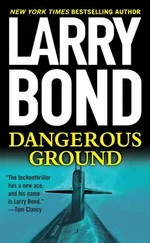Irina nodded. “Yes, but I’ve been looking at the computer screen for hours and hours updating our story. I haven’t been keeping up with the news.”
“I’ve been so worried about my Yakov, and the rest of our men on Severodvinsk. The American government has said, officially, that Seawolf suffered one dead and several injured. And the families were all told within hours!”
“But the American captain could talk to them, with that satellite phone.”
“And that same American captain can talk to Severodvinsk, too!” Olga stormed. “What do they know? Who’s hurt? Who’s dead?”
Irina sighed. “Our Navy doesn’t trust the Americans.”
Olga quickly retorted, “I don’t care. I’d talk to the devil himself if he could tell me how Yakov is. Are those bloated toads afraid of lies from the Americans? They’re so full of lies themselves, a few more shouldn’t bother them.”
Irina leafed through the printouts. “There is another American ship in the area. They are sending a helicopter to their submarine to get the injured sailors.”
“Which means they can talk to Seawolf ,” Olga concluded. “I wish we could give the submarine captain our phone number. He could just call me with that satellite phone of his. Or the ship. It’s probably against the law, but I wish we had a radio. I want to talk to that ship.”
Irina smiled. “We have something better than radio, Olga — email.”
Twenty-fourth Independent Long Range ASW Regiment, Severomorsk-1 Air Base, Russia
Four Il-38s made up the first wave. With the weather finally clearing, it was time for the Russian Navy to show they were making an all-out effort. Interfax news crews invited by the Navy filmed the big four-engine patrol planes as they thundered down the runway.
Positioned at the end of the runway, the film crews got dramatic footage of the planes climbing against a backdrop of ragged overcast.
The Navy spokesman, a pilot himself, gave the interviewer a detailed description of the plane’s antisubmarine sensors and its weapons load. He made a point of mentioning that because the search area was relatively close, the planes would be carrying their maximum load of antisubmarine sensors and ordnance. They would be over the collision site in less than an hour.
9 October 2008
0730/7:30 AM
USS Winston S. Churchill, 145nm bearing 078° from USS Seawolf
It had cleared overnight. A few high, thin clouds couldn’t interfere with the bright daylight. The light held no warmth, though, and with Churchill still racing east-northeast at twenty-five knots, the chilly air turned into a frigid blast.
Captain Baker had allowed Patterson and others from her party to watch the helicopter launch. They huddled in a safe spot just behind the after exhaust stack, escorted by Churchill’s XO.
It was a strange and exciting place, full of motion: the sea, the deck, the wind, and the whirling helicopter blades made her hold on to a fitting for some feeling of solidity.
She was also surrounded by reminders of Churchill’ s true purpose. In front of them, between the helicopter pad and the exhaust stack, was the “after VLS magazine.” The size of a tennis court, it was covered with sixty-four two-foot-square hatches. Lieutenant Commander Hampton had explained that an antiaircraft missile was housed under each one. Two stories above on the superstructure behind her, she could see a pair of circular missile illuminators. They would guide those missiles to targets a hundred miles away.
Right beside her, a Phalanx gun mount partially blocked the wind as it whipped by. Hampton had described it as a “killer robot,” armed with a radar-directed 20mm gatling gun. She wondered if he wasn’t sensationalizing things a little, and reminded herself to look up the Phalanx on the Internet.
And then there was the helicopter, turbines spooling up. Patterson was grateful for the wind, because it carried part of the sound aft, away from them. What was left still made conversation impossible.
The Seahawk could carry missiles or torpedoes, but this time it carried tanks with extra fuel. She’d seen helicopters before, even ridden in them occasionally, but not like this one. They seemed small and vulnerable by comparison, like insects in their complexity and fragility. This beast was two or three times larger, vibrating with power as the pilot tested the engines, straining at the leash.
Lieutenant Commander Hampton proudly explained the evolution as the helicopter was brought out of the portside hangar and prepared for flight. It all happened quickly as the machine was moved out, the blades unfolded, and the engines started. An enlisted phone talker stood near the group and provided updates on the launch.
The talker tapped Hampton on the shoulder, and the XO leaned close and listened to the enlisted man’s report. Hampton turned and signaled to the group. Shouting over the wind and the engine noise, he said, “The Captain’s going to slow us down now. The helicopter’s ready, so we have to slow to reduce the air turbulence near the ship.”
Patterson and the others nodded, and within a minute the force of the wind lessened. The helicopter suddenly rose and turned to port, falling aft as the ship moved ahead. The Seahawk then banked and headed east-northeast, paralleling and preceding Churchill along that course.
Hampton nodded to the petty officer, who unscrewed his phone cord from a jack in the bulkhead. The XO ushered the group toward a watertight door, and they began filing inside. Patterson hung back, letting the others go first, and Hampton remarked, “They’ll be tracked by Russian radar soon. We’ve detected aircraft to the north, both a land-based patrol plane and a radar helicopter.”
He saw her look of alarm, and quickly reassured her. “Both types can’t harm a helicopter, and there is no indication that anyone will interfere with the helicopter’s mission.”
Then he paused. “But as long as the Russians are treating this as a tactical situation, we’re going to be on guard.” He looked to the northeast. The Seahawk helicopter was just visible. “None of us will relax until they’re back aboard.”
Rider 02, on course 078°
The Seahawk helicopter cruised at one hundred knots. He could go faster, up to a hundred and fifty, but he’d burn fuel too quickly. The pilot held the craft in a slow climb. Like all aviators, he liked distance from the unforgiving ocean, and it expanded his horizon. The increased altitude helped Churchill’s radar to keep tracking him, and his own sensors could see farther.
And his own radar was definitely on. They’d seen the Russian radars operating before he’d even taken off, so there was no point in trying to be electronically quiet. Besides, his APS-147 radar was an excellent sensor. As he rode over an empty sea, with home falling away behind, those sensors guided him, and gave him the knowledge he needed to get his job done and find his way home.
The flight proved to be smoother than they had originally thought, and they had a great tailwind. After only forty-three minutes in the air, they got their first glimpse of the injured submarine. “Contact at five eight miles, bearing zero seven niner,” the sensor operator reported.
The pilot acknowledged the message, then ordered, “Tell Seawolf we have them on radar.”
USS Seawolf
The XO poked his head into the crew’s mess. “They’re about thirty minutes out,” he said hurriedly, and disappeared. Just aft of the midships escape trunk, Chief Gallant had staged the three crewmen who were to be evacuated. EN2 Brann had been heavily dosed with painkillers, and his broken leg had been padded with blankets. Along with MM1 Heiser, he sat quietly. ET1 Troy Kearney fidgeted, and occasionally looked at the chief like he wanted to speak, but Gallant glared him down.
Читать дальше












